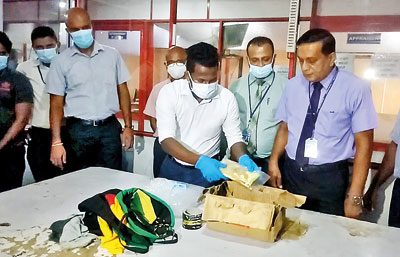News
Pandemic or no pandemic, it’s business as usual for drug smugglers despite arrests and detection
Last year’s countrywide lockdowns and travel restrictions did not lead to a decline in narcotics-related arrests, National Dangerous Drug Board statistics show.
The figures indicate that in the first six month of last year alone, 45,013 arrests were made for drug-related crimes. Of them 23,203 people were arrested for heroin-related offences and 20,640 for cannabis-related offences. The figures more or less correspond to the 2019 statistics.

Customs officials at the BIA inspect a package containing 95 grams of Cocaine. One suspect was arrested. Pic by Hiran Priyankara
In 2019, the total number of drug related arrests was 89,321. Of these arrests, 40,970 were heroin related and 45,923 were cannabis related. These arrests were made while the previous government launched a major drive to eliminate illegal drugs from the country and took drastic measures to control the menace. The then President Maithripala Sirisena in June 2019 even signed the death warrants for four drug convicts, signalling a break in the 43-year-old moratorium on capital punishment. He believed such drastic action was necessary to combat drug-related crimes.
The new government that came to office last year also launched a major campaign against drug criminals, despite the outbreak of the pandemic.
The pandemic may have restricted the movement of people but not the drug smuggling which seemed to find new routes into the country.
NDDCB figures indicate a shift in the demand for the synthetic psychotropic drug methamphetamine, also known as ICE and crystal meth. According to the NDDCB, only about 35.4 kilograms of ICE were detected in 2019, but in 2020, around 856 kilograms were detected.
According to the Sri Lanka Customs, there is an increasing use of postal and courier services to smuggle narcotics drugs to the county.
Spokesman Sadatta Silva said that several courier parcels had been intercepted and found to have drugs concealed inside.
On April 27, five courier parcels containing Kush (cannabis from the Kush Hindu mountains) and ICE were detected. The drugs with a street value of Rs. 7 million had been sent from the United States, England and Germany. They have been posted to addresses in Homagama, Ahangama, Werahera and Kandy.
Also last month, Customs officials found 4,962 synthetic narcotic pills in a package that had come from Paris via Dubai, while the Police Narcotics Bureau seized two parcels of narcotic pills sent from Dubai.
In 2020, the Customs detected parcels carrying drugs worth Rs. 250 million.
In February the Sri Lanka Navy (SLN) seized 400 kilograms of heroin and 100 kilograms of ICE from a boat in Sri Lanka waters. The detection came two months after Excise Department officials arrested four suspects and seized 100 kilograms of meth and 100 kilograms of heroin during a raid in Marawila.
Post Master General Ranjith Ariyaratne said that going by the recent detections they could see a shift in the type of drugs being smuggled in and the modus operandi. Previously it was heroin but now meth and psychotropic drugs abound because of the big profit involved and the convenience in packing. A pill is easily sold at Rs. 4,000 to Rs. 5,000 he said.
This year alone more than Rs. 100 million worth of illegal drugs had been detected at the Central Mail Exchange, the PMG said, adding that private courier services were also being used to smuggle in drugs.
Explaining how they make detections at the Central Mail Exchange, Mr. Ariyaratne said they worked in collaboration with the Sri Lanka Customs which has its own offices in mail exchange centres in Colombo, Kandy, Galle and Jaffna. The premises are equipped with cctv cameras and scanners while they also use sniffer dogs to make the detection.
When a suspected parcel was spotted, it would be retained and a notice sent to the address sent to the intended recipient, the PMG said, pointing out that often, the addresses in the parcels were fake. Asked why the postal services were still the favoured route of the drug smugglers, Mr. Ariyaratne said they suspected that drug traffickers operated with inside help. They learnt of detection no sooner they were made and would not turn up to collect the parcels.
Meanwhile, heroin and cannabis are continued to be smuggled in through the sea route. Last week, in a mid-sea operation, nine Iranians were arrested with 107 kilograms of heroin in their trawler.
In March, the Indian media reported that a trans-border racket had been busted by Indian coast guards when they intercepted three Sri Lankan boats carrying 300 kilograms of heroin worth Indian Rs. 3000 cores off the coast of Trivendram.
Meanwhile, NDDCB Chairman Dr. Laknath Welagedera said that meth had been in use in Sri Lanka for long time, but only now it was being detected more frequently. Meth was more harmful than cocaine, because of its high strength, he said, warning that youngsters should refrain from experimenting with the drug.
“Users can get easily addicted. Once they get hooked to it, it will be hard to rehabilitate them,” he said. Those who need rehabilitation should contact the NDDCB hotline 1927.


